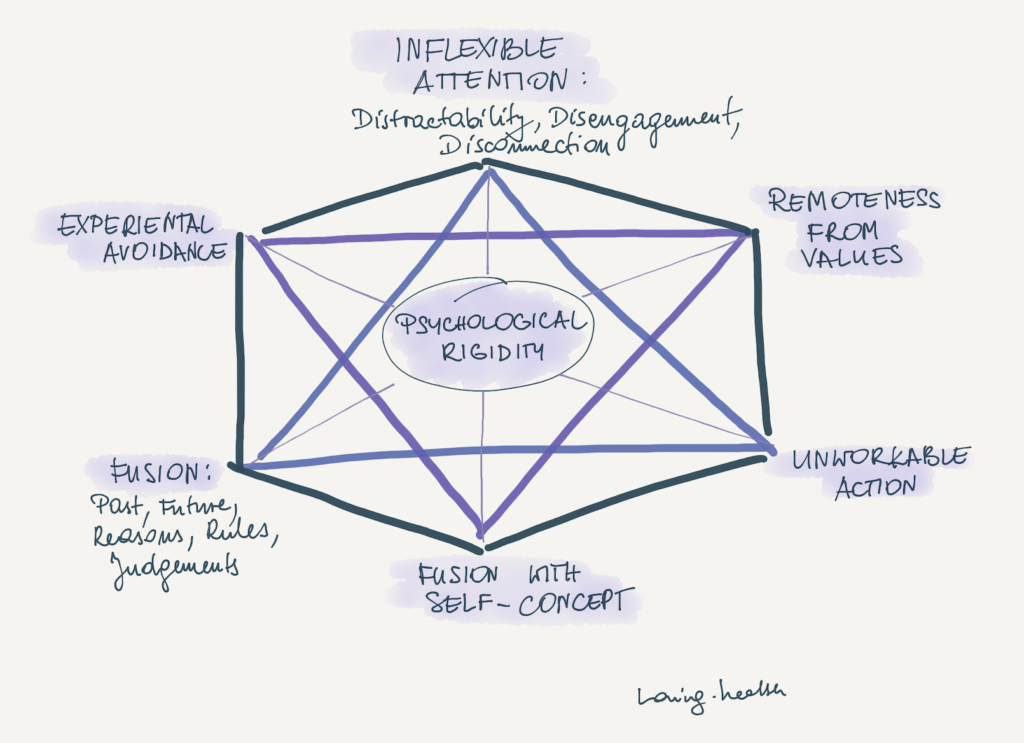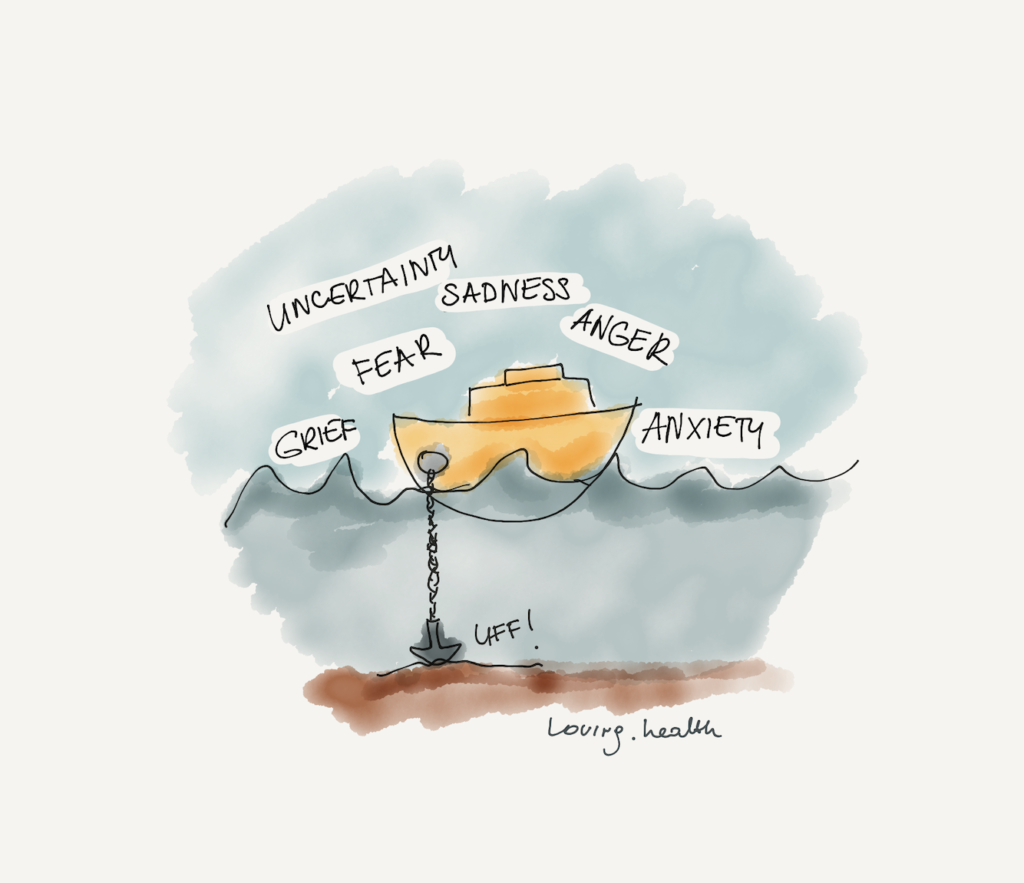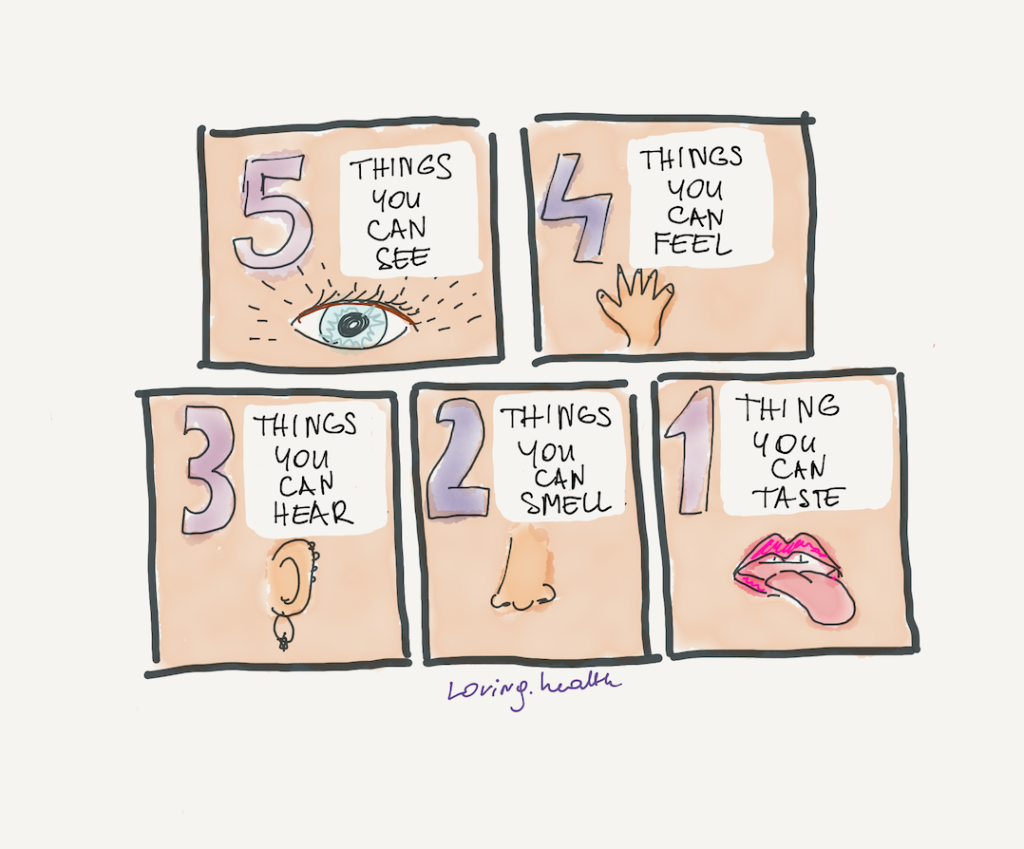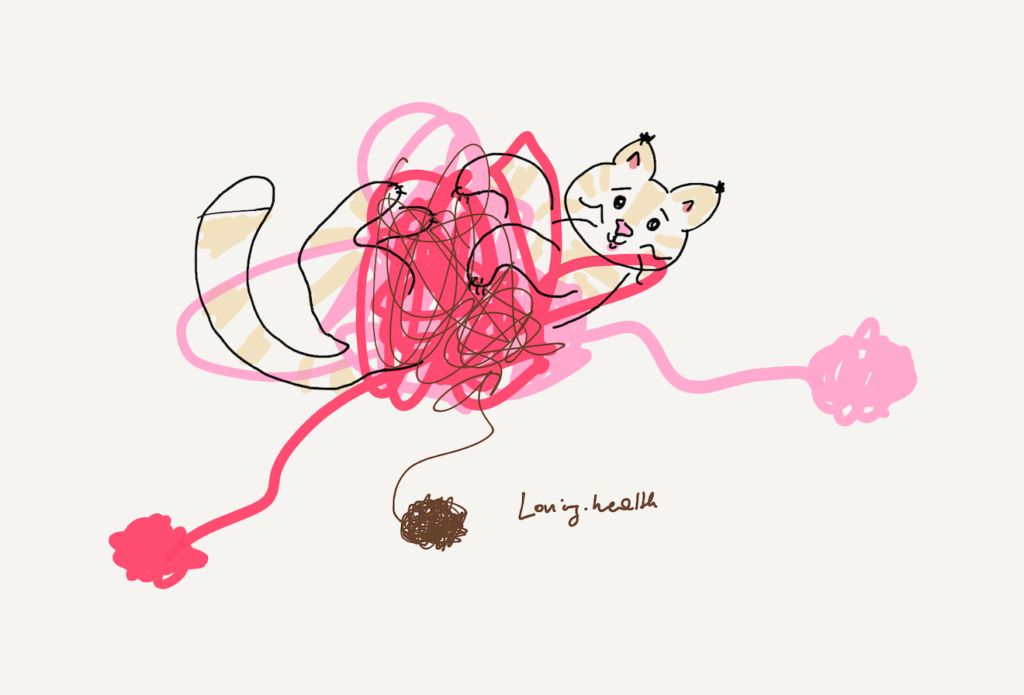Author: Olga Goralewicz, ACT Specialist
Anxiety, in all its different forms, is one of the most common mental health challenges today.
Acceptance and Commitment Therapy (ACT) is effective against many mental health disorders, like Generalized Anxiety Disorder (GAD), social anxiety, and substance abuse. Clients are taught to train their psychological flexibility to deal with difficult situations instead of avoiding them.
This kind of therapy relies heavily on the client’s experience and behavior. So, let’s have a look at what that’s like for a person with anxiety.
How does a person with anxiety act?
Anxiety is a state of tension aroused by a specific trigger. Those triggers are different from person to person. As Charles Duhigg (author of The Power of Habit) says there are 5 types of triggers: time, location, emotional state, preceding events, and other people. Some common ones include:
- social interaction,
- exams and tests,
- school and work,
- visiting doctor’s offices and hospitals, as well as
- new environments and situations.
A person with anxiety likely has the tendency to go out of their way to avoid anything that triggers their uneasiness.
What does that mean in practice? Take a look at the two examples.
- Avoiding a football game because you simply aren’t interested in sports and you know you will be bored.
- Yearning for an intimate relationship and at the same time avoiding any and all social situations because they make you feel anxious.
The first example is a healthy response to what you “feel like doing”.
The second introduces a no-win situation. You can’t get what you want, because you are not ready to take chances at the cost of feeling anxiety.
Unless you learn to accept some unpleasantness in return for satisfaction, you will be stuck in this paradox. On the other hand, there is no point in forcing yourself into situations that are not going to give you any emotional reward. Because anxiety is not a pleasant feeling by definition, it takes motivation and openness to face it.
What is ACT for anxiety disorders about?
In the spirit of ACT, we call anxiety Experiential Avoidance Disorder. This is because it is based on avoiding situations, behaviors, and emotions in order to prevent negative private experiences. It becomes an issue when this stops you from living the life you want.
Psychological Rigidity
Although avoidance is the main part of the problem, there are other aspects that make our suffering worse. Think of a dark hexagonal diamond where each of the tops is a piece of psychological rigidity.
The more you identify with each one of them, the less likely it is that you are living a meaningful, fulfilling life. In other words, it’s a place where you can look for answers when things go wrong.
The following model shows ACT’s 6 Core Principles and their psychopathological counterparts.

In our What is ACT? article you can find a detailed rundown of Acceptance, Defusion, Contact with the Present Moment, Self-as-context, Values, and Committed Action.
Here, let’s concentrate on what happens when those processes are not implemented or implemented incorrectly in terms of anxiety.
Experiential avoidance
Anxiety easily leads clients to refuse to do anything that triggers their anxiety. Instead of working through the problem to live a fulfilling life, they withdraw from many things they used to enjoy.
Inflexible attention
You can’t change the past and you don’t know what the future holds. The only thing you can control is the present moment.
Anxiety has a way of occupying our thoughts, dragging us away from what is happening right now. Clients often can’t control going over anxiety episodes in the past and thinking about anticipating future ones.
Fusion with self-concept
When you begin to think of yourself as one with your private experiences (including thoughts and feelings), physical body, and expectations from others, these phenomena are a lot more threatening.
It’s not easy to change yourself. This way of understanding is damaging because if you look at these matters from the outside, they are much simpler to change and solve. When you lose objectivity, you can’t ever understand a situation fully.
Fusion
Humans as a species are constantly tormented with unpleasant thoughts, feelings, and sensations. A healthy response is to judge them as they are – separate from you.
Anxiety can make clients unable to see where the ME ends and where private experiences begin. This fusion makes thoughts such as “I can’t handle this situation” a lot stronger.
Remoteness from values
Recognizing what is truly important to you makes the decision-making process a lot easier and a lot more productive. Allowing external influences guide your life leads to a lack of self-satisfaction.
It is easy to get caught up in fulfilling the expectations of others and society. When we succeed we don’t feel satisfaction, when we fail, we are no closer to feeling fulfilled.
Unworkable action
Taking steps to achieve goals that mean nothing to you is a waste of time. In the case of anxiety, clients concentrate on creating a life void of their triggers. It may help slightly in the short term but creates habits that become damaging.
For example, a person with social anxiety often does want a close relationship. However, the mechanisms they develop through avoiding social contexts render achieving this impossible.
So, once again, make a quick scan through that hexagon and ask yourself with no judgment Where can I make a change?
And if that experiment seems to bring a lot of emotional suffering, try to work through that with a specialist.
Turning psychological rigidity into psychological flexibility
Acceptance and Commitment Therapy teaches clients to assess whether a certain action will provide them with more satisfaction or more anxiety. In the case of the latter, intervention is not necessary.
If, however, you find yourself withdrawing from things you previously enjoyed or which you aspire towards, there are four steps you can take:
- Accept that life includes both pleasant and unpleasant thoughts and sensations.
- Define your values and what you want your life to be.
- Take committed action to achieve your goals.
- Connecting with your body.
Acceptance
Anxiety does not go away on its own. What’s more, the harder you try to fight it, the more intense it becomes. Imagine anxiety as a rash – the more you scratch it, the worse it gets.
Why? Because anxiety is not the enemy here, it is a natural function of the human body.
It can be useful to distinguish “clean” anxiety from “dirty” anxiety.
“Clean” anxiety is when our emotions, feelings, thoughts, memories appear spontaneously and flow through our life naturally. This may sound easy, but it actually takes heavy-duty acceptance and letting go skills to achieve.
“Dirty” anxiety, on the other hand, is the avoidance of experiences or attempting to control them. It’s basically “anxiety about anxiety”.
For example, the feeling I get during these pandemic times is a sense of chaos in my house, which makes me feel anxious. Having this anxiety brings thoughts about being a good/bad mum which makes me even more anxious. It’s a vicious cycle.
So, what’s the solution? Try to accept your anxiety and distance yourself from it. You will not get rid of your symptoms by fighting and struggling with them.
Acceptance doesn’t mean you need to embrace things, it means that even if you don’t like the feeling, you can make room for it.
Most types of Western psychology aim to develop behavior change strategies. ACT helps you realize what actions you can undertake that will actually lead to a meaningful life, not what will help you avoid anxiety triggers.
Defining your values
Our values are what dictates the life we want to live. Figuring out what those are for you is an important step in engaging with Acceptance and Commitment Therapy. Here is a quick values exercise that will help you begin.
Once you begin to feel the benefits of placing yourself in situations that trigger your anxiety, you will be more committed to changing your behavior.
Plus, research shows that if you do the things in life that matter to you, your suffering is likely to go down (Gloster, 2017).
Taking committed action
As the name suggests, ACT therapy concentrates on acceptance and commitment. So once you accept what you can’t change, you can focus on what is in your control.
Committed action means taking effective steps guided by values that are important to you. Something you do because it is of great importance, even when it involves difficult thoughts and feelings.
Look at the values you chose as the most important ones. Choose a few and come up with an exercise you can do every day. For example, if your value is friendship, try to engage in a conversation with someone every day.
The next step could be to try and share something personal. Do what feels natural and what you feel brings you satisfaction.
We have a much greater influence on our behavior than on our thoughts and feelings. So our ultimate goal is to manage our behavior, here and now, in order to react appropriately. This applies to both our private experiences and the external problems we need to face.
Contacting your body
People with anxiety often develop damaging coping strategies which disconnect them from unpleasant physical sensations. The most common method is overthinking. They ruminate about their anxiety – this distracts them from actually feeling it, but only for a moment.
Going over anxiety episodes and worrying about future ones may deceivably feel like problem-solving. Unfortunately what often happens instead is more anxiety, as there is often little to learn from the experience.
This process makes us feel more restless than we began with. So, how to intercept this vicious cycle?
Feeling in touch with your body is an essential part of ACT practice. It teaches you to know exactly what is going on with you physically. The skill will allow you to feel anxiety coming on and notice the feeling before it becomes overwhelming.
When you feel anxious, ask yourself the following questions:
- Is there a trigger? What is it?
- What physical reactions can I feel, faster heartbeat, breathing?
- How can I recognize the state of feeling anxious?
- What were the first signs I noticed?
By doing this consistently, you will eventually be able to recognize an anxiety episode before it comes. And you won’t see anxiety as a label but more as an unfolding physical experience in your body.
Connecting and being in the body, not only in my head, was my favorite personal discovery.
ACT techniques for self-help
Acceptance and Commitment Therapy strategies can be used to administer self-help. Here are a few examples of things you can do when you feel an anxiety attack coming on. You can also download this workbook with anxiety worksheets PDF.
Dropping the anchor and the ACE formula

Imagine ships in a marina during a raging storm. If anchors weren’t cast, they would sail deep into the sea or even sink. An anchor does not make the storm calm down or go away. It does, however, keep the ship steady until it clears up.
Everyone experiences an “emotional storm” when a crisis arises. We don’t want to get carried away. So how do we drop a metaphorical anchor?
The ACE formula is an easy and practical tool that helps with this exercise.
Acknowledge your thoughts and feelings
Calmly and silently take note of what you are experiencing. Try to name your:
- thoughts,
- feelings,
- emotions,
- memories,
- impressions, and
- drives.
Inspect your private experiences like a scientist, a curious observer.
Come back into your body
Separate those from your body. Focus on what you physically feel and which muscles are tense. There are many methods of doing this, for example:
- Press your feet into the ground.
- Raise your arms and stretch.
- If you are sitting, lean forward in the chair.
- Join your fingers together and apply light pressure.
- Move your neck around.
- Take a few deep breaths. Take in as much air as you can, and then release all of it, until your lungs feel empty.
You can also come up with your own ways to ground yourself. Whatever works.
Engage in what you’re doing
Look around. Where are you? What is the context of the situation?

Try to engage all five senses. Name:
- something you can see,
- something you can smell,
- any sounds you hear,
- if you can taste anything, and finally
- is anything touching you? How do the clothes feel on your body? Soft? Tight? Are you under a blanket?
The exercise should take you at least 3 minutes. If you find it takes you a lot less, repeat each step.
“Dropping the anchor” is an exercise you can use whenever a difficult feeling, thought, memory arises. Practice makes perfect. The more you ground yourself, the more control you will have over your emotions and feelings. Or better, how you react and treat them.
This coloring exercise may help you recognize and locate your feelings.
Getting unstuck

Modern research has found 6 common mechanisms that keep people “stuck”. This means lingering in a vicious cycle of anxiety that is hard to escape without very particular coping skills.
Let’s explore the ways we get stuck and how we can go about dealing with it.
Forgetting who you really are
Have you ever called yourself an “anxious person”? As symptoms get more and more intense, we often feel like they are becoming a part of our personality.
In reality, anxiety is a state, an emotion, not a part of you. Even just describing yourself with this adjective can make you really believe that there is no escape.
Getting stuck in anxious thoughts
Anxious thoughts are powerful. And they are that way because of a very particular mechanism – the more you struggle with them and try to distract yourself, the more prevalent they become.
Undertaking fruitless efforts
We all have the tendency to find a way to fight anxiety off. Even when the efforts are not paying off, we repeat the same steps.
Clinging to avoidance
A popular way to deal with anxiety is avoiding the triggers. It may seem like this lowers your levels of anxiety. In fact, they are still there just as strong, or even stronger. And stopping yourself from doing anything that brings it on can make you unhappy, closed off from the world, and lonely.
Being out of touch
Whenever you feel anxious, you likely try to distract yourself by thinking about the past and the future. While it may feel like it’s working, you lose touch with the present moment. And that is the only time when you can take action.
Not having as much time to think about life
When all your efforts go towards lowering anxiety levels, that hardly leaves time for anything else. Your one and only pursuit in life is to stay calm. This can make even the easiest task difficult, not to mention functioning in society, going to work, and chasing goals.
What happens during ACT sessions with a coach/therapist?
Acceptance and Commitment Therapy sessions begin with psycho-education about how the theory works.
The second step might be practicing mindfulness skills and contacting your body which will make it easier to recognize private experiences. Negative ones will be recontextualized, in order to help you create distance between them and you.
Remember, anxiety is a message, so the goal is not to get rid of it but to understand its function.
The therapist may then discuss with you how your actions are in contrast with your values. In the case of anxiety, you will talk about how avoiding certain situations may be making you unhappy.
Your coach/therapist might assign homeworks to practice mindfulness skills and core principles between sessions. These could be as simple as going grocery shopping or more advanced, like sharing something personal with a colleague.
ACT is highly adaptable and may look different for different people. Therapists and clients often co-create strategies and techniques that work in a particular situation.
How is ACT different from CBT?
The main difference on the subject of ACT vs CBT is that the latter does not work to minimize the frequency or severity of negative private experiences. The goal is rather to learn to let them come and go without struggling.
This is particularly effective with anxiety, as we tend to have anxiety about having anxiety. ACT helps us escape this vicious cycle.
What therapy works best for anxiety?
What works for one person may not work for someone else. Acceptance and Commitment Therapy, however, has proven very effective with Generalized Anxiety Disorder (GAD).
If you have found that previous attempts to control your anxiety did not work, it’s worth giving it a shot. There have been several dozen randomized controlled trials using ACT specifically for anxiety (ACBS, 2020).
ACT is a third-wave behavior therapy based on Relational Frame Theory (RFT) which understands thoughts and other cognitive processes as language. The goal is not to look at private experiences as a part of you. They come and go, and the only thing you can control is your behavior, here and now.
In order to get rid of symptoms and unwanted behaviors, the therapy concentrates on the source issue. First of all, is it a problem at all? Will you have any benefits from forcing yourself in engaging with anxiety-inducing situations, or is it just an expectation from others?
Behavior change should always be guided by personal values, not social norms.
Once that is established, clients are taught to take valued direction towards the life they want to live. ACT understands mental health as a state in which we accept that life is not always going to be calm, quiet, and easy.
Imagine the happiest day of your life. Surely, it still contained elements of stress, sadness, and frustration. But those feelings weren’t strong enough to have an impact on how you perceive that day.
That is what ACT aims to teach with all difficult sensations. Clients train psychological flexibility in order to experience a meaningful life.


